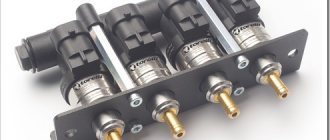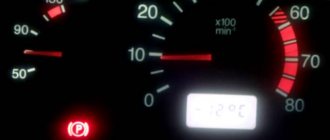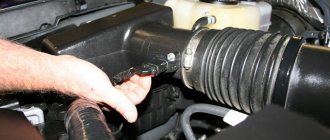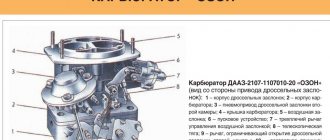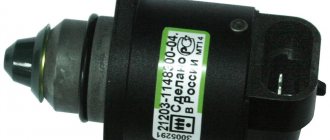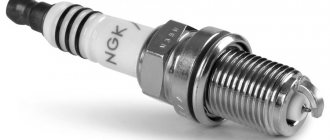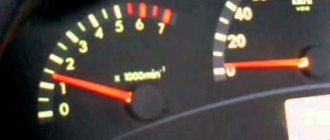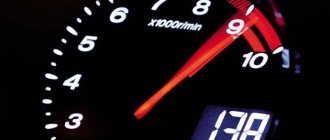What to do if the idle speed of a VAZ 2107 jumps, is there any panacea for this? The fuel system causes a lot of trouble for owners, but one thing needs to be taken into account - it is not always to blame. For example, in carburetor engines with a classic ignition system, there is a high probability of contact group failure if there is instability in the idle speed. But with injection engines everything is somewhat simpler. And now about everything in more detail.
Carburetor speed fluctuates
You rarely see imported components on domestic cars.
Basically, AvtoVAZ engines are equipped with a Solex or Ozone carburetor. Less often you can find products from the Dimitrovgrad Aggregate Plant, known for its reliability: the DAAZ carburetor. Drivers of relatively modern cars, accustomed to the check engine light, can easily determine any malfunction using an on-board computer or an inexpensive car scanner, but for veteran engine owners, only hardware diagnostics are available. A common malfunction is idle speed floating, the main symptoms are:
- It would seem that the problem does not affect the speed - with intensive use of the gas pedal, the malfunction is invisible. However, it is dangerous in traffic jams, when the engine may suddenly stall, and when engine braking on a long descent;
- In addition, increased vibrations do not add life to the motor and attachments. Bearings of rotating shafts experience axial loads that are not typical for them. And it is uncomfortable for passengers to be in the car when the tachometer needle jumps from 500 to 1500 rpm.
The driver is forced to constantly apply gas, this distracts from the road and increases gas consumption.
So, manifestations of floating idle:
- The tachometer needle moves smoothly or sharply in the range of 1000 revolutions;
- The car shakes noticeably: there is always a feeling that it will stall;
- Pops of unburned fuel in the muffler and under the hood. In the first case, the mixture is rich, in the second, it is lean;
- Vibrations similar to tripping (at the same time you are sure that the spark plugs and the high-voltage part of the ignition system are in good condition);
- The motor randomly picks up speed, then smoothly reduces it. The problem is non-linear, it suddenly appears and also disappears suddenly (this somewhat complicates the diagnosis).
It is not difficult to localize the fault. If (we repeat: in the absence of other malfunctions), the speed fluctuates, look at the carburetor.
Carrying out diagnostics
The simplest method is to measure the voltage at the block to which the regulator is connected. These are terminals D and A. When the ignition is turned on, a voltage of 12 V should be present on them. If the voltage is less than this value, it is worth looking at the battery and generator. It is quite possible that the battery is undercharged. In the same case, if there is no voltage at all, it is necessary to check the entire power circuit of the device and diagnose the ECU.
Set the multimeter to resistance measurement mode. Between pairs of terminals A and B, C and D, there should be a resistance of approximately 53 ohms. Remove the IAC and connect (with the ignition off) to the block. Then turn on the ignition and look at the behavior of the needle - it should extend completely when voltage is applied. If this does not happen, we can judge that the IAC is broken.
Sometimes simply cleaning the regulator helps. To do this, you can use sprays, of which there are sufficient quantities in stores. But in some cases, only replacing the device will help. Of course, this is not a DAAZ carburetor, the cost of the IAC will be many times lower, and there will be no problems with replacement. If, even after the replacement, the engine does not idle, it is necessary to fully diagnose the injector.
Welcome, friends, to the DIY car repair website. One of the very common problems found on almost all cars is floating idle speed.
RPM fluctuates at idle
Such a minor (at first glance) malfunction is very annoying and can cause a lot of inconvenience on the road. For example, at an intersection, a car can stall at any time when the speed decreases.
The driver, in turn, has to constantly apply pressure to the gas to keep the engine in good shape.
Purpose and design of the idle speed controller.
The idle speed regulator is designed to regulate the amount of atmospheric air entering through the bypass channel (bypass) into the suction manifold when the engine is idling. The main channel is closed by the throttle valve.
The regulator is a DC electric motor. It has two windings on the stator and a rotor with permanent magnets. The rotor is connected to the rod by a lead screw. At the end of the rod there is a valve that closes the hole in the bypass. Power is supplied either to the first or to the second stator winding. At the same time, the rotor rotates in one direction and then in the other, extending or retracting the rod and the valve with it using a screw.
Checking the EPHH needle valve.
We also remove the hose from the side outlet (fitting “2”) of the electro-pneumatic valve and connect this hose to the economizer. We start the engine. If the economizer valve is working properly, the engine should run at low speed. If the engine stalls at idle, the valve diaphragm may rupture.
To change the valve, disconnect the wires from the microswitch terminals.
2. Using a screwdriver, unscrew the two screws securing the economizer housing to the carburetor.
3. Remove the bracket with the microswitch...
4. ...as well as the economizer assembly.
5. Remove the gasket from the economizer.
6. Unscrew the two bolts holding the body and economizer cover together...
7. We halve the economizer and check the condition of the diaphragm.
If the diaphragm is defective or the needle and seat are worn, we replace the economizer assembly.
On older models it was possible to change parts individually.
We install the new economizer in the reverse order.
How is everything going?
When everything is fine, you start the car and wait for the engine to warm up. In this case, the tachometer needle is at the level of 2-2.5 thousand revolutions and gradually drops during warming up to 800-900 revolutions per minute.
But it also happens differently. Immediately after starting the engine or after some time, you notice that the engine speed is fluctuating. In this case, you can do nothing - the machine seems to live its own life.
The range of oscillations can be large - from 500 to 1,500 rpm. As a rule, after 5-10 minutes this problem goes away, but the next time everything repeats again and again.
In such a situation, you cannot remain idle - you must find out why the idle speed is floating. This is the only way to eliminate the problem and forget about it like a bad dream.
IAC breakdowns
If you have a VAZ 2107 with an injection engine, then pay due attention to the condition of the vehicle systems. If the speed on an injection engine fluctuates, then you need to look first at the idle speed control. The fact is that the breakdown of such a mechanism as the IAC can lead to very sad consequences, including a traffic accident. Here are the main signs by which you can independently determine whether the regulator is broken:
- The engine begins to “live its own life” - the crankshaft rotation speed is constantly changing, sometimes decreasing, sometimes increasing. Consequently, the tachometer needle constantly floats.
- When you start a cold engine, the crankshaft speed does not increase, it fluctuates within a certain range.
- If you turn on powerful electrical appliances (for example, a car radio, low or high beam), the speed decreases and does not return to the set level.
- When you engage the neutral gear, the engine begins to stall if you do not apply the gas pedal from time to time.
These are the main signs that the regulator is faulty. In fact, any interruptions in the idle level are the first sign of a breakdown or minor defect in the IAC. But the time has come to diagnose it. It won't be difficult to do this.
The following problems are also possible:
- Excessive (low) gasoline level in the float chamber.
- The air filter is clogged (here you can save yourself with a regular replacement).
- In modern cars with an injection engine and electronic fuel injection, such as the VAZ 2110-2115, no less reasons can be identified. In this case, problems are often associated with the breakdown of one of the sensors.
What happens? The electronic control unit tries to read information and does not receive it. As a result, malfunctions in the operation of the power unit appear, and instability in speed appears.
But let's highlight all the main reasons. There are several of them:
- Problems with spark plugs (poor quality, wear, contamination);
- interruptions in the air supply (failure of the mass air flow sensor);
- air intake from outside into the intake system;
- damage (defect) of high-voltage wires;
- failure of the XX regulator;
- EGR sensor malfunction.
When the idle speed is floating, the first thing to do is check the idle speed control. Most often it is located next to another sensor that controls the throttle position. Checking is carried out using a multimeter.
If the sensor resistance is outside the normal range (40-80 Ohms), then there is a high probability of IAC failure.
If everything is normal with the idle speed control, you can move on to the next “suspect” - the mass air flow sensor.
To check the device, you need to disconnect the connector from it and start the engine. In this case, the engine speed will be around 1,500 rpm. If the dynamics only improve while driving, then the mass air flow sensor is really faulty.
The EGR valve is responsible for the movement of exhaust gases. The sensor's task is to return some of the gases back to the combustion chamber. This is necessary to ensure complete combustion of fuel and minimal harm from exhaust gases. Cleaning the valve seat is often enough to fix the problem.
3. In diesel cars, the cause of floating idle speed may be the appearance of corrosion on the moving blades in the power pump. As a result, they simply jam and stop coping with their function.
To prevent this from happening, you need to add at least a little motor oil to the fuel tank (200-250 grams is enough). This is enough to protect the metal elements with a thin layer of oil.
Now floating idle speeds will not cause you to panic, because you know what causes them and what needs to be done. Good luck on the roads and of course no breakdowns.
Didn't find the information you are looking for? on our
If you find an error, please highlight a piece of text and press Ctrl Enter.
What about the injector?
Everything is a little simpler here, since no adjustments are needed. The reason is that a smart on-board control system is responsible for everything. And specifically for idling - the regulator (IAC). Some may call it an idle speed sensor, but this concept is completely wrong. The fact is that there are two types of devices on injection cars - sensors (reading) and actuators. The idle air control is a stepper motor; it does not measure anything, but on the contrary, it opens and closes the air supply through a special channel.
A breakdown of the IAC can only be determined by external signs, and then only relatively. The fact is that the control lamp on the dashboard will not light up if the regulator suddenly fails. But if you feel unstable revolutions, or they have disappeared completely, and the engine jerks and stalls, then first of all, of course, it is worth checking the performance of the IAC. It is worth noting that sometimes the “Check” can light up when the IAC is faulty. This happens if the engine detonates. The knock sensor signals a malfunction to the electronic control unit.
If the car stalls
An engine that suddenly stops not only creates an inconvenient driving experience, but also poses a safety hazard to the driver and passengers. There are several reasons.
Stalls at idle:
- failure of the idle speed sensor;
- failure of the throttle sensor;
- failure of the throttle position sensor.
Stalls while driving:
- interruption of fuel or air supply due to a dirty filter;
- fuel pump malfunction;
- clogged carburetor jets;
- engine overheating.
When diagnosing a car whose engine stalls in the most unexpected places, it is better to start by checking the idle speed sensor.
It's easy to check its functionality. Dismantle the device without removing the contacts, or connect them after dismantling. Hold the device in your hands, place your finger on the cone needle and ask a friend to turn on the ignition. If you feel shocks, then install the device back. The idle speed sensor is OK.
If the throttle sensor fails, the car will not only stall, but also will not start, because the ECU will give a command for maximum fuel release, the spark plugs will flood and the engine will stall.
If you are on the road in a VAZ car and there is a problem with the throttle sensor, then it’s easier not to bother and contact the nearest service center, but if you make it to the garage, you can use the following instructions:
- Remove the sensor.
- Using a 2 mm drill, drill out the plastic cover in a circle.
- Remove the plastic pad of the upper contact group.
- On the lower platform, clean the paths with WD-40 or alcohol.
- The same with the contact group of the top cover, but do not bend them, they will then eat the tracks prematurely.
- Reassemble in reverse order.
- Apply any plastic glue along the contour.
Checking the electro-pneumatic valve control unit.
You will find the control unit for the EPHH electro-pneumatic valve on the left mudguard in the engine compartment.
Gradually increase engine speed. At engine speeds of 1500–2000 rpm, the voltmeter readings will drop abruptly to 0.5–1.5 V or the warning light will go out.
We replace the faulty unit with a new one, for this...
4. ...disconnect the connector...
5. ...and use a screwdriver to unscrew the two screws securing the block to the mudguard. Next, we install the new EPHH block in reverse order.
Let's sum it up
There are dozens of types of breakdowns that lead to a sharp or gradual drop in speed on carburetor cars. But the question is that the equipment turns out to be quite demanding in terms of maintenance, so all the reasons have to be eliminated together. If you always encounter such a problem, it means that this is a specific operation of the carburetor installed in your car. Most likely, only replacing the device will help get rid of the troubles. If the problem only occurred a few times, you should try servicing the fuel system, replacing the filter and installing a new carburetor repair kit.
Cars with this type of injection are gradually giving way to injection systems. They are more reliable, more economical, last longer and do not cause such troubles as carburetors. Of course, there are also many subtleties and features in direct injection that should be kept in mind. But changing a carburetor to an injector is too labor-intensive and expensive. It is better to properly maintain your equipment and ensure its normal operation. Even with very good service, after 1-2 years you will have to go to the service again. Have you ever experienced a sharp drop in engine speed when warming up?
Specifications
Before we begin to describe the malfunctions, it is worth considering the engine options that were installed on the VAZ 2107 carburetor. The characteristics and design of the engine are quite simple. The engine has an in-line longitudinal arrangement of cylinders.
So, for the VAZ 2107 with carburetor versions of power units, engines marked 2103 and 2106 were installed.
VAZ 2103
| Name | Index |
| Volume | 1.5 liter (1452 cm3) |
| Number of cylinders | 4 |
| Number of valves | 8 |
| Power | 80 hp |
| Fuel | Gasoline with the possibility of installing gas cylinder equipment |
| Cooling | Liquid |
| Injection system | Carburetor |
| Fuel consumption | 6,7 |
| Cylinder diameter | 76 |
| Cylinder operating order | 1-3-4-2 |
VAZ 2106
| Name | Index |
| Volume | 1.6 liter (1569 cc) |
| Number of cylinders | 4 |
| Number of valves | 8 |
| Power | 75 hp |
| Fuel | Gasoline with the possibility of installing gas cylinder equipment |
| Injection system | Carburetor |
| Fuel consumption | 6,7 |
| Cylinder diameter | 79 mm |
| Cylinder operating order | 1-3-4-2 |
The engines were equipped with gearboxes manufactured by VAZ - 4-speed manual transmission and 5-speed manual transmission. Unlike new models, all power units have a timing chain instead of a belt. Unlike the “fives”, the seventh model of the Zhiguli has higher engine power and displacement.
Maintenance of the VAZ 2107 engine is quite simple. So, the engine requires scheduled maintenance every 10,000 km. Many motorists are wondering what kind of oil to pour into the engine? Considering the design of the engine, the most suitable option is “semi-synthetic”.
Many car enthusiasts argue that it is better to pour “mineral water” or “synthetic” in general. Of course, an engine with high-quality oil will run longer, but in the case of the “seven” even the manufacturer recommends using “semi-synthetic”. But for power units equipped with an injector rather than a carburetor, it is already recommended to use a higher criterion motor oil - “synthetic”.
Idle speed fluctuates, causes, malfunctions
Understand that there are many reasons for the engine to be unstable at idle. In this case, much depends on the type of engine - carburetor, injection or diesel. Let's look at each of the options:
- Let's start with domestic cars with a carburetor engine (for example, VAZ 2107 or VAZ 2109). So, why do the idle speeds fluctuate in our favorite “classics”.
There are several reasons:
The engine idle speed is incorrectly adjusted or it has gone astray during operation. At the same time, the setting shifted towards depletion of the fuel assembly (fuel-air mixture).
In this case, you just need to adjust the speed to 800-900 rpm; read the article on adjusting the carburetor yourself.
The carburetor solenoid valve has failed. In this case, the motor will only work when the choke is extended. If you remove the choke, the engine will immediately stall.
The idle air system jets or channels are dirty. If this happens, the fuel is starved of air as it enters the engine. The problem is often solved by simply cleaning the jet.
The sucking of “extra” air into the carburetor system inevitably leads to a lean mixture. As a result, the engine begins to stall and stall.
Why is the engine speed unstable?
When it comes to the carburetor, there are several reasons:
- The carburetor is clogged, the movement of air and gasoline becomes impossible.
- The operation of the solenoid valve is disrupted - the winding is burned out or the nozzle is clogged.
- Fuel or air filters are clogged.
- Incorrect carburetor adjustments on VAZ 2107.
In most cases, the culprit is the solenoid valve. Its appearance is shown in the photo. It is necessary in the power system for the following purpose - it opens the fuel supply when the ignition is turned on and closes it when it is turned off. Consequently, the engine stops immediately after turning off the ignition.
The VAZ 2107 carburetor solenoid valve is a small device consisting of the following elements:
- Frame.
- Winding (one end connected to a metal body).
- A rod that acts as a valve that opens and closes the fuel supply at idle.
- Copper jet with holes. Please note that the jets are marked; there are several sizes.
The solenoid valve operates only when the ignition is on. If suddenly there is a break in the power circuit, you can temporarily connect the central wire of the device to the positive terminal of the battery. Just try to carry out repairs as soon as possible.
The speed of the VAZ 2107 carburetor floats
There may be several reasons for this unpleasant problem:
The IAC idle speed controller is malfunctioning
The idle speed of the engine changes by itself and it may even stop; often the engine does not want to start without pressing the gas pedal. And the “Check Engine” lamp may not light up. At medium and high speeds, the engine keeps its speed evenly, and no loss of power is noticeable.
Problems with the mass air flow sensor (mass air flow sensor)
If the mass air flow sensor is faulty, the speed may change not only at idle speed, but also at any other throttle opening, even when driving under load. A car can put its owner in a very dangerous situation by suddenly losing traction while overtaking. The check engine light is usually on. If you notice these signs, you will need to replace the faulty sensor. Read how to do this here
Air leaks through cracks in hoses and seals
Excess air that enters the engine intake tract bypassing the mass air flow sensor depletes the combustible mixture. The speed and power of the motor changes, the controller tries to correct this. As a result, the speed and “traction” change. But unlike the case with a faulty mass air flow sensor, this does not happen so abruptly. The Check Engine light does not come on.
Carefully inspect all tubes and hoses that extend from the throttle body, gaskets, the throttle body itself, and the intake manifold for cracks. Pay special attention to the hose going to the vacuum brake booster, as it often cracks. It also happens that the vacuum booster itself begins to “poison” the air and then when you press the brake pedal, the engine speed will change. Eliminate all these faults and the engine will start running smoothly again.
Other reasons
A car is a very complex system and it is simply impossible to describe the incredible variety of possible combinations of breakdowns. The engine may “jerk” when driving and change speed due to a malfunction of the ignition system, injectors, bad gasoline, water getting into the tank, dirty filters, etc. In each specific case, you need to carefully analyze all the signs and draw conclusions. If all else fails, you can always undergo verification diagnostics with a motor tester.
What is idle air control
When we release the gas pedal, the throttle valve closes completely, blocking the path of air into the intake manifold. In this case, engine operation is ensured by a small cross-section bypass channel, through which air flows for idle operation. A device is installed in the channel that has the ability to change its flow area and even completely block it. This mechanism is the idle speed regulator. With its help, the ECU controller can maintain and change engine speed at idle. For what? For example, when we start a cold engine and it runs unsteadily, when we turn on the heating or air conditioning, thereby adding to the load. Having received information from the crankshaft speed sensors, throttle position, speed sensor, and temperature, the controller processes it and sends a command to the idle speed controller - “add air” or “reduce air.” As a result, we have stable and smooth engine operation when the gas pedal is released.
How he does it? A stepper motor is hidden inside the housing. Short pulses are applied alternately to its two stator windings and the rotor shaft rotates to a certain angle. A screw connected to the rotor acts on the throttling element (needle), pushing it out or pushing it into the hole. The flow area of the channel changes, and the idle speed changes accordingly.
Idle air control - device, connection, general view
The regulator may stop working for various reasons. Most often, the mechanical part fails - the needle drive parts break or jam. Idle air regulators bought in stores “on the cheap” are especially prone to this because of their low quality. Failures of the electrical part occur less frequently - burnout of windings, wire breaks, wear or corrosion of the contact block.
Before replacing the regulator, we need to make sure that the reason is in it, and not in the power supply wires and connectors. To do this, turn on the multimeter in the mode up to 20 volts, check the voltage at contacts “B” “D” with the ignition on. It should be about +12 volts. If the voltage = 0 or is much lower, then the cause of the malfunction is somewhere else. It is necessary to check all circuits from the controller to the regulator and the controller itself.
Which one should I buy as a replacement?
A regulator from VAZ injection models is suitable, for example this one 2112-1148300-02 from the twelfth model. When choosing, pay attention to the build quality and packaging. It is better to buy products from large, well-known manufacturers. And it doesn’t hurt to ask the seller which ones they take more often.
does not hold idle speed | Topic author: Ozzie
does not hold idle speed what to do first vaz 21043 carb
Alexey (Farrar) Whatever you are going to do with the carb, first of all, adjust the level in the float chamber and check (change if necessary) the needle valve. Well.
Alexey (Farrar) the solenoid valve is clogged, clean it.
Denis (Elixabete) Alexey, even if I just want to adjust the idle, for example? The level in the chamber, as a rule, does not go down for very long. Roman, as Alexey answered above, check the EM valve. It looks like a metal cylinder screwed into the carb on the right side of the car. One wire goes to it. You can check by turning on the ignition and removing and connecting the wire, the valve should click. If it doesn’t click, check the battery (case - minus, terminal - plus). If it clicks, it means the valve control system is faulty, you need to dig further. You need to buy a valve with a red rubber band, with a black one - this is a cooperative.
Roman (Arachne) Denis, THANK YOU ALL, I SOLVED THE PROBLEM OF THE cams AND REPLACED THE CONDENSER
Alexey (Farrar) 2022. Contact ignition. Roman, I, too, due to my age, am a conservative. But not to the same extent. ))
Saiman (Ismail) has the air filter been changed recently?
Yulchik (Tomasso) I also can’t rev up, I’ve tried everything, the carb doesn’t help. We checked the ignition too, tell me what could be wrong and it still jerks after 50 km/h
Sergey (Lavada) I remove the choke, it stalls, I don’t even move, but while the choke is there, I set it to 1500 and it works as usual! But the trouble was, when I was clearing the PTF wires from the ground, I touched some kind of hose with my hand, and I don’t even know what kind of hose it is! Maybe someone can tell me what?
Alexey (Farrar) Come here https://twokarburators.ru/index.php? option=com_content.. On the right, find your problem and read. And this link was here https://vk.com/topic-10193261_24978922
Sergey (Lavada) Alexey, you see, this is not the case that the engine is running in full force but only works on suction. And now I look at the engine warm-up arrow, it’s already even in the middle of the white stripe, I quietly smoothly remove the choke and the engine smoothly STALLS and doesn’t pull at all, that’s the reason. Apparently, because as my neighbor (mechanic) told me, yesterday I accidentally touched the hose that goes from the crankcase to the carb, I carefully stuck it in place, as it seemed to me! I knew for sure that this was a very necessary hose, I was even very right, but I didn’t know and don’t know what it was for. I'll look in Murzilka but I don't think I'll understand right away
Sergey (Lavada) Alexey, I can post a photo
Alexey (Farrar) Murzilka is good. But the link I gave you is much cooler and more complete. Don't waste time on photos - read.
Sergey (Lavada) Alexey, I’m saying that my problem is not there
Sergey (Lavada) Alexey, I wrote everything that happened. Two days ago I was idling without gas, but today it’s hell.
Alexey (Farrar) Oh, I understand - do you want a ready-made answer? Or instead of learning the structure of the carb and making it complete, do you want to correspond? I envy you have a lot of time.
Sergey (Lavada) Alexey, well, a ready-made answer won’t hurt. Moreover, people in a dialogue can say more information than is written anywhere! Most sources describe special cases. This is the same as in mathematics, only in it special cases are rare, but here it’s the other way around.
Sergey (Lavada) Alexey, especially since I’m unlikely to be able to do a complete s/o carb on my own because I really don’t have enough time, I also have to go to university. Yes, and finally master the city, otherwise I only travel around the region and have never been to the city.
Alexey (Farrar) Well, until I went for a walk with my daughter. let's talk, When was the last time you checked and adjusted the level in the float chamber, changed the needle valve, cleaned the carb?
Sergey (Lavada) Alexey, O_o ))) I have never touched it at all, I even know the location in theory, presumably I know the principle of operation no more
Tags: VAZ 2107 carburetor idle speed fluctuates
Causes of failure of the carburetor VAZ 2107
Here we will describe step by step all the possible reasons that the VAZ 2107 starts and stalls.
Lack of fuel in the float chamber
If the cause of a carburetor breakdown is the lack of fuel in the float chamber, then there is a high probability that the fuel pump or power system is also faulty. Simply remove the hose from the fuel inlet fitting. After this, make a couple of presses on the lever to manually supply fuel. Gasoline should flow out of the hose hole. If the stream was weak or completely absent, then you need to carry out a detailed check of the fuel pump and power system.
Carburetor inlet strainer clogged
A clogged filter is also a common cause of carburetor failure.
It will be very easy to correct this reason. You will need to remove the strainer and then clean it. For cleaning purposes, you should use a toothbrush, or something similar. You can try rinsing the filter with acetone. A can of compressed air can also help. Blow through the entire filter with it. Clean the filter seat. Sometimes it may be necessary to completely replace this part, but it is better to just try to clean it.
Broken solenoid valve or fuel jet of the idle system
First of all, you need to look at the position of the fuel jet and solenoid valve. As a result of some kind of breakdown, it can turn away, which is why the breakdown occurs. Just turn it on. Also try removing the wire from the valve and putting it back on. You should hear a characteristic click. It indicates that the valve is working. If you do not hear a click, then connect the battery positive and the valve terminal. If you do not hear a click, then the valve will need to be replaced. If there is a click, it is worth checking the EPH system.
The serviceability of the valve can be checked by removing the fuel nozzle from it. Examine it carefully. It should not be contaminated or damaged. Look at the O-ring and the locking needle. The jet should be thoroughly cleaned and blown out with compressed air.
Air leak into carburetor
This is a very broad problem that will be difficult to fix. It doesn't always cause the car to stall. This can happen if the fuel mixture is very lean with excess air. This is the reason why the carburetor in the VAZ 2107 starts and stalls. In this case, you need to check the entire carburetor.
- Ring under the valve;
- Tube to vacuum chamber;
- Tube to valve cover;
- Quality screw ring.
Sometimes it will be easier to replace the entire carburetor.
Trigger diaphragm damaged
If the reason is the trigger diaphragm, then it will have to be completely disassembled and inspected. Sometimes it may be necessary to completely replace the starter, but not often. It will need to be adjusted. Be sure to replace the diaphragm with a new one.
Clogged fuel and air jets
Emulsion wells and dosing system tubes may also be clogged.
You will need to disassemble the carburetor, remove the above parts and clean them. To clean, you need to use acetone, a brush and a can of compressed air. They must be cleaned of all visible contaminants. It is worth noting that in Solex and ozone systems the components will be the same. Only their location differs.
- Air jets;
- Emulsion tubes;
- Fuel jets;
- Emulsion wells.
All components need to be cleaned, even if some of them are not very dirty. This will help avoid repeated breakdowns.
Clogged fuel and air jets of the idle system
Clogging of these areas of the carburetor can also cause the VAZ 2107 to start and immediately stall. In this case, you will have to disassemble them. This is quite easy to do, you just need to carefully unscrew the jets. Next you need to clean them and blow them with compressed air. Sometimes they may need to be replaced. You can try cleaning the jets without completely disassembling the carburetor. This will significantly reduce cleaning time.
The fuel level in the float chamber is broken
This is a very common reason why the carburetor stalls in a VAZ 2107. This is due to improper adjustment of the fuel level. The fact is that the fuel mixture is disrupted. It can be highly enriched, or vice versa, depleted. In this case, adjustments need to be made. It may take a long time, but this way you can avoid carburetor malfunctions.
Choke not adjusted
Because the choke may not be fully open, the fuel may become richer. Most often this does not lead to serious problems, but sometimes the fuel becomes so rich that the engine is very difficult to start. Especially if it has been heated by long driving. In this case, it is worth adjusting the air damper (suction). Sometimes a highly enriched mixture can even flood the candles.
If the air damper is working correctly, it should cover the cross section of the right chamber. This occurs when the handle is fully extended. And if the handle is recessed, then it should stand vertically. If this does not happen, then the cause of the carburetor breakdown is precisely the incorrect adjustment of the choke. Adjusting it shouldn't take you much time.
Methodology for finding problems on domestic carburetor systems
Before you start troubleshooting, you need to check that the carburetor is adjusted correctly. The manufacturer sets the settings for ideal operating conditions - the amount of oxygen in the atmosphere of flat terrain and gasoline that complies with GOST. And this is on a new car.
In reality, periodic adjustment of all 4-5 carburetor adjustment screws is required. At least two of them are responsible for stable idle operation. The adjustment is made with the engine running using a simple screwdriver.
The procedure is described in the owner's manual, and differs slightly depending on the carburetor model. The main condition for correct tuning is the absence of leaks, a clean air filter, and high-quality gasoline. The amount of oxygen in the air corresponds to daily use. That is, if you live on a plain, there is no point in adjusting the carburetor while climbing a mountain serpentine to an altitude of 800 meters above sea level.
- Warm up the engine to a temperature of 90°C. If there is no thermometer, the degree of heating can be easily determined by the opening of the cooling system thermostat;
- We start the engine, give a small load - turn on the headlights and the climate system (without air conditioning). Each type of carburetor has its own idle speed, let’s take 750-800 rpm as a basis, as on Solex. The idle speed is controlled by the “quantity” and “quality” screws of the mixture. It will not be possible to establish normal speed with wine alone;
- The forced choke lever (choke) is closed;
- Using the “quality” screw, we adjust the speed to the maximum possible value. As a rule, the screw is fixed at the factory and closed with a plug. It needs to be removed;
- Next, using a standard (on the dashboard) or remote tachometer, set the speed to 900, turning only the “quantity” screw;
- Then use the “quality” screw to set the required value: 750-800 rpm.
Afterwards, you need to start the engine in normal mode, make a test drive, and accelerate in neutral several times to the maximum speed. Then turn off the engine, and after a couple of minutes start it again and check the number of revolutions at idle with a load (high beam + heater). If necessary, repeat the adjustment process.
